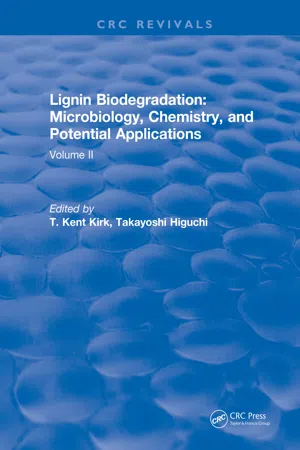
Lignin Biodegradation: Microbiology, Chemistry, and Potential Applications
Volume II
- 270 pages
- English
- ePUB (mobile friendly)
- Available on iOS & Android
About This Book
Lignin is a generic name for the complex aromatic polymers that are major components of vascular plant tissues. Lignin is abundant; in terms of weight it is probably second only to cellulose among renewable organic materials, and in terms of energy content it might well be the single most abundant. an international seminar on lignin biodegradation was organized and was held May 9 to 11, 1978, at the U.S. Forest Products Laboratory in Madison, Wisconsin. This book records the proceedings of that seminar and is meant to provide a summary of research. Each speaker/author was asked to summarize his research, including his latest unpublished results, and to describe how his work fits into the overall picture. Following two orientation chapters, one a review of lignin structure and morphological distribution in plant cell walls, and the second a review of the microbial catabolism of relevant aromatics, the book is comprised of chapters in the three subject areas given by the book's title. It does, as intended, provide comprehensive coverage of research to date (August 1978).
Frequently asked questions
Information
Chapter 1
Degradation of Lignin and Lignin-Related Substances by Sporotrichum Pul Verulentum (Phanerochaete Chrysosporium)
I. Introduction
II. DEGRADATION OF LIGNIN BY S. pulverulentum AND OTHER WHITE ROT FUNGI
A. The Influence of Carbohydrates and Cellobiose:Quinone Oxidoreductase on Lignin Degradation
B. The Importance of Phenol Oxidase Activity in Lignin Degradation
Table of contents
- Cover
- Copyright Page
- Foreword
- The Editors
- Seminar
- Contributors
- Table of Contents
- Chapter 1 Degradation of Lignin and Lignin-Related Substances by Sporotrichum Pul Verulentum (Phanerochaete Chrysosporium)
- Chapter 2 The Role of Laccase in Lignin Biodegradation
- Chapter 3 Enzymatic Transformations of Lignin
- Chapter 4 Physiology of Lignin Metabolism by White-Rot Fungi
- Chapter 5 Genetic and Biochemical Studies on Phanerochaete Chrysosporium and Their Relation to Lignin Degradation
- Chapter 6 Microbial Metabolism of Lignin-Related Aromatics
- Chapter 7 Isolation and Characterization of Lignocellulose-Decomposing Actinomycetes
- Chapter 8 Degradation of Lignin-Related Aromatics and Lignins by Several Pseudomonads
- Chapter 9 Metabolism of Lignin-Related Compounds by Bacteria
- Chapter 10 Biodegradation of Lignin-Related Polystyrenes
- Chapter 11 Microbial Decolorization and Defoaming of Pulping Waste Liquors
- Chapter 12 Regulation and Genetics of The Biodegradation of Lignin Derivatives in Pulp Mill Effluents
- Chapter 13 Lignin Biodegradation and The Production of Ethyl Alcohol from Cellulose
- Chapter 14 Biomechanical Pulping
- Chapter 15 Ultrastructural Changes in The Wall of Spruce Tracheids Degraded by Sporotrichum Pulverulentum
- Chapter 16 Lignin Biodegradation: Summary and Perspectives
- Subject Index
- Chemical Index